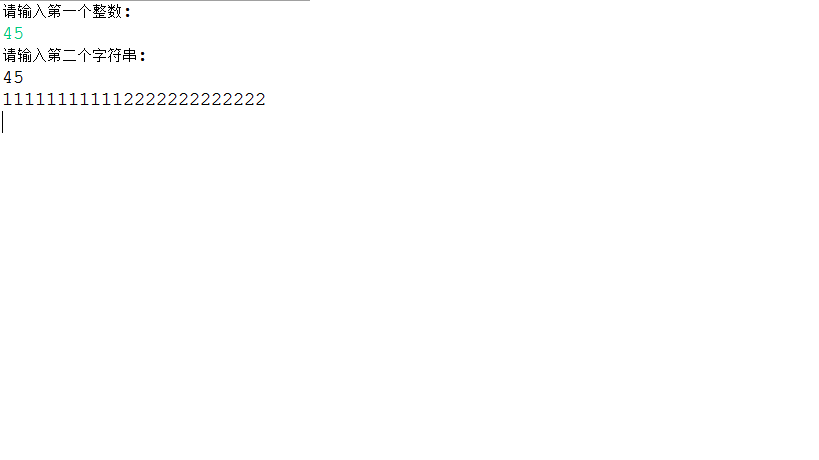Scanner的概述和方法介绍
- A:Scanner的概述
B:Scanner的构造方法原理
- Scanner(InputStream source)
- System类下有一个静态的字段:
- public static final InputStream in; 标准的输入流,对应着键盘录入。
C:一般方法
- hasNextXxx() 判断是否还有下一个输入项,其中Xxx可以是Int,Double等。如果需要判断是否包含下一个字符串,则可以省略Xxx
- nextXxx() 获取下一个输入项。Xxx的含义和上个方法中的Xxx相同,默认情况下,Scanner使用空格,回车等作为分隔符
Scanner :键盘录入数据.
nextInt:键盘录入一个int.
nextLine:键盘输入一个字符串.
nextShort:键盘输入一个Short类型的数
nextLong:键盘输入一个long类型的数
……
例如输入一个int数
public class Demo2 {
public static void main(String[] args) {
Scanner sc = new Scanner(System.in);
int i = sc.nextInt();
System.out.println(i);
}
}
hasNextXX:
hasNextInt():判断输入的是不是int类型.,返回的值为boolean类型
hasNextLine();判断输入的存在一行.,返回的值为boolean类型
hasNextFloat();判断输入的是不是为float类型, 返回的值为boolean类型
………
例如:输入整数判断
import java.util.Scanner;
public class Demo_Scanner {
public static void main(String args[]) {
Scanner sc = new Scanner(System.in);
if(sc.hasNextInt()){
int i=sc.nextInt();
System.out.println(i);
}
else{
System.out.println("输入类型错误!");
}
}
}
键盘录入问题:
public class Demo2 {
public static void main(String[] args) {
Scanner sc = new Scanner(System.in);
/*
* nextInt()是键盘录入整数的方法,当我们录入10的时候
* 其实在键盘上录入的是10和\r\n,nextInt()方法只获取10就结束了
* nextLine()是键盘录入字符串的方法,可以接收任意类型,但是他凭什么能获取一行呢?
* 通过\r\n,只要遇到\r\n就证明一行结束
*/
System.out.println("请输入第一个整数:");
int i = sc.nextInt();
System.out.println("请输入第二个字符串:");
String line2 = sc.nextLine();
//System.out.println("i = " + i + ", line2 = " + line2);
System.out.println(i);
System.out.print("11111111111");
System.out.print(line2);
System.out.println("2222222222222");
}
}
此图可以可以看出: “System.out.print(line2);”已经执行但是没有值.
遇到此种问题怎么解决?
/*
* 解决方案“
-
* 1,创建两次对象,但是浪费空间
* 2,键盘录入的都是字符串,都用nextLine方法,后面我们会学习讲整数字符串转换成整数的方法
*/
int i = sc.nextInt();
Scanner sc2 = new Scanner(System.in);
String line = sc2.nextLine();
System.out.println(i);
System.out.println(line);
String类的概述
A:String类的概述
* 通过JDK提供的API,查看String类的说明
* 可以看到这样的两句话。
* a:字符串字面值"abc"也可以看成是一个字符串对象。
* b:字符串是常量,一旦被赋值,就不能被改变。
String构造方法演示
public class Demo_StringCon {
/**
* public String():空构造
* public String(byte[] bytes):把字节数组转成字符串
* public String(byte[] bytes,int index,int length):把字节数组的一部分转成字符串
* public String(char[] value):把字符数组转成字符串
* public String(char[] value,int index,int count):把字符数组的一部分转成字符串
* public String(String original):把字符串常量值转成字符串
*/
public static void main(String[] args) {
String arr=new String();
System.out.println(arr);
byte[] arr1={97,98,99,100}; //将字节数组转化成字符串
String a=new String(arr1); //解码,将计算机读的懂的转换成我们读的懂
System.out.println(a);
byte[] arr2={56,97,98,99,100,101,12}; // 把字节数组的一部分转化成字符串
String b=new String(arr2,2,4); //将arr2字节数组从2索引开始转换4个
System.out.println(b);
char[] arr3={'a','b','c','d','e','f','g'};
String c=new String(arr3);
System.out.println(c);
String d=new String(arr3,2,4); //把字节数组一部分转化成字符串
System.out.println(d); //将arr3字节数组从2索引开始转换4个
String f=new String("abcd");
System.out.println(f); //把字符串常量值转成字符串
}
}
String类中的面试题
/**
* * 1.判断定义为String类型的s1和s2是否相等
* String s1 = “abc”;
* String s2 = “abc”;
* System.out.println(s1 == s2); ture //常量池中没有这个字符串对象,就创建一个,如果有直接用即可
* System.out.println(s1.equals(s2)); false
* 2.下面这句话在内存中创建了几个对象?
* String s1 = new String(“abc”); 俩个对象 一个是在常量区 一个是在堆内存中
* 3.判断定义为String类型的s1和s2是否相等
* String s1 = new String(“abc”);
* String s2 = “abc”;
* System.out.println(s1 == s2); false 一个堆内存 一个在常量区
* System.out.println(s1.equals(s2)); true
* 4.判断定义为String类型的s1和s2是否相等
* String s1 = “a” + “b” + “c”;
* String s2 = “abc”;
* System.out.println(s1 == s2); true 常量优化机制
* System.out.println(s1.equals(s2)); true
* 5.判断定义为String类型的s1和s2是否相等
* String s1 = “ab”;
* String s2 = “abc”;
* String s3 = s1 + “c”;
* System.out.println(s3 == s2); false 没有常量优化机制,一个在常量区 一个在堆内存中
* System.out.println(s3.equals(s2)); true
*/
String类的判断功能
/**
* boolean equals(Object obj):比较字符串的内容是否相同,区分大小写
* boolean equalsIgnoreCase(String str):比较字符串的内容是否相同,忽略大小写
* boolean contains(String str):判断大字符串中是否包含小字符串
* boolean startsWith(String str):判断字符串是否以某个指定的字符串开头
* boolean endsWith(String str):判断字符串是否以某个指定的字符串结尾
* boolean isEmpty():判断字符串是否为空。
*
* “”和null的区别
* “”是字符串常量,同时也是一个String类的对象,既然是对象当然可以调用String类中的方法
* null是空常量,不能调用任何的方法,否则会出现空指针异常,null常量可以给任意的引用数据类型赋值
*/
模拟用户登录实现
import java.util.Scanner;
public class Text1 {
public static void main(String[] args) {
Scanner sc = new Scanner(System.in);
System.out.println("请登录");
for (int i = 1; i < 4; i++) {
System.out.println("请输入用户名:");
String username = sc.nextLine();
System.out.println("请输入密码:");
String password = sc.nextLine();
if ("admin".equals(username) && "admin".equals(password)) {
System.out.println(username + "恭喜您!登录成功");
break;
} else if (i == 3) {
System.out.println("您的机会已经用完了!");
} else {
System.out.println("密码错误!");
System.out.println("您还有" + (3 - i) + "次机会了");
}
}
}
}
String类的获取功能
public class Demo5_StringMethod {
/**
* * int length():获取字符串的长度。
* char charAt(int index):获取指定索引位置的字符
* int indexOf(int ch):返回指定字符在此字符串中第一次出现处的索引。
* int indexOf(String str):返回指定字符串在此字符串中第一次出现处的索引。
* int indexOf(int ch,int fromIndex):返回指定字符在此字符串中从指定位置后第一次出现处的索引。
* int indexOf(String str,int fromIndex):返回指定字符串在此字符串中从指定位置后第一次出现处的索引。
* lastIndexOf
* String substring(int start):从指定位置开始截取字符串,默认到末尾。
* String substring(int start,int end):从指定位置开始到指定位置结束截取字符串。
*/
public static void main(String[] args) {
//demo1();
//demo2();
//demo3();
//demo4();
String s = "woaiheima";
s.substring(4); //subString会产生一个新额字符串,需要将新的字符串记录
System.out.println(s);
}
private static void demo4() {
String s1 = "heimawudi";
String s2 = s1.substring(5);
System.out.println(s2);
String s3 = s1.substring(0, 5); //包含头,不包含尾,左闭右开
System.out.println(s3);
}
private static void demo3() {
String s1 = "woaiheima";
int index1 = s1.indexOf('a', 3); //从指定位置开始向后找
System.out.println(index1);
int index2 = s1.lastIndexOf('a'); //从后向前找,第一次出现的字符
System.out.println(index2);
int index3 = s1.lastIndexOf('a', 7); //从指定位置向前找
System.out.println(index3);
}
private static void demo2() {
String s1 = "heima";
int index = s1.indexOf('e'); //参数接收的是int类型的,传递char类型的会自动提升
System.out.println(index);
int index2 = s1.indexOf('z'); //如果不存在返回就是-1
System.out.println(index2);
int index3 = s1.indexOf("ma"); //获取字符串中第一个字符出现的位置
System.out.println(index3);
int index4 = s1.indexOf("ia");
System.out.println(index4);
}
private static void demo1() {
//int[] arr = {11,22,33};
//System.out.println(arr.length); //数组中的length是属性
String s1 = "heima";
System.out.println(s1.length()); //length()是一个方法,获取的是每一个字符的个数
String s2 = "你要减肥,造吗?";
System.out.println(s2.length());
char c = s2.charAt(5); //根据索引获取对应位置的字符
System.out.println(c);
char c2 = s2.charAt(10); //StringIndexOutOfBoundsException字符串索引越界异常
System.out.println(c2);
}
}
字符串的遍历
public class Demo6_StringMethod {
/**
* * byte[] getBytes():把字符串转换为字节数组。
* char[] toCharArray():把字符串转换为字符数组。
* static String valueOf(char[] chs):把字符数组转成字符串。
* static String valueOf(int i):把int类型的数据转成字符串。
* 注意:String类的valueOf方法可以把任意类型的数据转成字符串。
* String toLowerCase():把字符串转成小写。(了解)
* String toUpperCase():把字符串转成大写。
* String concat(String str):把字符串拼接。
*/
public static void main(String[] args) {
//demo1();
//demo2();
//demo3();
String s1 = "heiMA";
String s2 = "chengxuYUAN";
String s3 = s1.toLowerCase();
String s4 = s2.toUpperCase();
System.out.println(s3);
System.out.println(s4);
System.out.println(s3 + s4); //用+拼接字符串更强大,可以用字符串与任意类型相加
System.out.println(s3.concat(s4)); //concat方法调用的和传入的都必须是字符串
}
private static void demo3() {
char[] arr = {'a','b','c'};
String s = String.valueOf(arr); //底层是由String类的构造方法完成的
System.out.println(s);
String s2 = String.valueOf(100); //将100转换为字符串
System.out.println(s2 + 100);
Person p1 = new Person("张三", 23);
System.out.println(p1);
String s3 = String.valueOf(p1); //调用的是对象的toString方法
System.out.println(s3);
}
private static void demo2() {
String s = "heima";
char[] arr = s.toCharArray(); //将字符串转换为字符数组
for (int i = 0; i < arr.length; i++) {
System.out.print(arr[i] + " ");
}
}
private static void demo1() {
String s1 = "abc";
byte[] arr = s1.getBytes();
for (int i = 0; i < arr.length; i++) {
//System.out.print(arr[i] + " ");
}
String s2 = "你好你好";
byte[] arr2 = s2.getBytes(); //通过gbk码表将字符串转换成字节数组
for (int i = 0; i < arr2.length; i++) { //编码:把我们看的懂转换为计算机看的懂得
//System.out.print(arr2[i] + " "); //gbk码表一个中文代表两个字节
} //gbk码表特点,中文的第一个字节肯定是负数
String s3 = "琲";
byte[] arr3 = s3.getBytes();
for (int i = 0; i < arr3.length; i++) {
System.out.print(arr3[i] + " ");
}
}
}
统计不同类型字符个数
public class Test3 {
/**
* A:案例演示
* 需求:统计一个字符串中大写字母字符,小写字母字符,数字字符出现的次数,其他字符出现的次数。
* ABCDEabcd123456!@#$%^
* 分析:字符串是有字符组成的,而字符的值都是有范围的,通过范围来判断是否包含该字符
* 如果包含就让计数器变量自增
*/
public static void main(String[] args) {
String s = "ABCDEabcd123456!@#$%^";
int big = 0;
int small = 0;
int num = 0;
int other = 0;
//1,获取每一个字符,通过for循环遍历
for(int i = 0; i < s.length(); i++) {
char c = s.charAt(i); //通过索引获取每一个字符
//2,判断字符是否在这个范围内
if(c >= 'A' && c <= 'Z') {
big++; //如果满足是大写字母,就让其对应的变量自增
}else if(c >= 'a' && c <= 'z') {
small++;
}else if(c >= '0' && c <= '9') {
num++;
}else {
other++;
}
}
//3,打印每一个计数器的结果
System.out.println(s + "中大写字母有:" + big + "个,小写字母有:" + small + "个,数字字符:"
+ num + "个,其他字符:" + other + "个");
}
}
按要求转换字符
public class Test4 {
/**
* * A:案例演示
* 需求:把一个字符串的首字母转成大写,其余为小写。(只考虑英文大小写字母字符)
* 链式编程:只要保证每次调用完方法返回的是对象,就可以继续调用
*/
public static void main(String[] args) {
String s = "woaiHEImaniaima";
String s2 = s.substring(0, 1).toUpperCase().concat(s.substring(1).toLowerCase());
System.out.println(s2);
}
}
String类的其他功能
public class Demo4_StringMethod {
/**
* boolean equals(Object obj):比较字符串的内容是否相同,区分大小写
* boolean equalsIgnoreCase(String str):比较字符串的内容是否相同,忽略大小写
* boolean contains(String str):判断大字符串中是否包含小字符串
* boolean startsWith(String str):判断字符串是否以某个指定的字符串开头
* boolean endsWith(String str):判断字符串是否以某个指定的字符串结尾
* boolean isEmpty():判断字符串是否为空。
*
* ""和null的区别
* ""是字符串常量,同时也是一个String类的对象,既然是对象当然可以调用String类中的方法
* null是空常量,不能调用任何的方法,否则会出现空指针异常,null常量可以给任意的引用数据类型赋值
*/
public static void main(String[] args) {
//demo1();
//demo2();
String s1 = "heima";
String s2 = "";
String s3 = null;
System.out.println(s1.isEmpty());
System.out.println(s2.isEmpty());
System.out.println(s3.isEmpty()); //java.lang.NullPointerException
}
private static void demo2() {
String s1 = "我爱heima,哈哈";
String s2 = "heima";
String s3 = "baima";
String s4 = "我爱";
String s5 = "哈哈";
System.out.println(s1.contains(s2)); //判断是否包含传入的字符串
System.out.println(s1.contains(s3));
System.out.println("------------------");
System.out.println(s1.startsWith(s4)); //判断是否以传入的字符串开头
System.out.println(s1.startsWith(s5));
System.out.println("------------------");
System.out.println(s1.endsWith(s4)); //判断是否以传入的字符串结尾
System.out.println(s1.endsWith(s5));
}
private static void demo1() {
String s1 = "heima";
String s2 = "heima";
String s3 = "HeiMa";
System.out.println(s1.equals(s2)); //true
System.out.println(s2.equals(s3)); //false
System.out.println("---------------");
System.out.println(s1.equalsIgnoreCase(s2));
System.out.println(s1.equalsIgnoreCase(s3)); //不区分大小写
}
}
把数组转成字符串,String类的转换功能
import com.heima.bean.Person;
public class Demo6_StringMethod {
/**
* * byte[] getBytes():把字符串转换为字节数组。
* char[] toCharArray():把字符串转换为字符数组。
* static String valueOf(char[] chs):把字符数组转成字符串。
* static String valueOf(int i):把int类型的数据转成字符串。
* 注意:String类的valueOf方法可以把任意类型的数据转成字符串。
* String toLowerCase():把字符串转成小写。(了解)
* String toUpperCase():把字符串转成大写。
* String concat(String str):把字符串拼接。
*/
public static void main(String[] args) {
//demo1();
//demo2();
//demo3();
String s1 = "heiMA";
String s2 = "chengxuYUAN";
String s3 = s1.toLowerCase();
String s4 = s2.toUpperCase();
System.out.println(s3);
System.out.println(s4);
System.out.println(s3 + s4); //用+拼接字符串更强大,可以用字符串与任意类型相加
System.out.println(s3.concat(s4)); //concat方法调用的和传入的都必须是字符串
}
private static void demo3() {
char[] arr = {'a','b','c'};
String s = String.valueOf(arr); //底层是由String类的构造方法完成的
System.out.println(s);
String s2 = String.valueOf(100); //将100转换为字符串
System.out.println(s2 + 100);
Person p1 = new Person("张三", 23);
System.out.println(p1);
String s3 = String.valueOf(p1); //调用的是对象的toString方法
System.out.println(s3);
}
private static void demo2() {
String s = "heima";
char[] arr = s.toCharArray(); //将字符串转换为字符数组
for (int i = 0; i < arr.length; i++) {
System.out.print(arr[i] + " ");
}
}
private static void demo1() {
String s1 = "abc";
byte[] arr = s1.getBytes();
for (int i = 0; i < arr.length; i++) {
//System.out.print(arr[i] + " ");
}
String s2 = "你好你好";
byte[] arr2 = s2.getBytes(); //通过gbk码表将字符串转换成字节数组
for (int i = 0; i < arr2.length; i++) { //编码:把我们看的懂转换为计算机看的懂得
//System.out.print(arr2[i] + " "); //gbk码表一个中文代表两个字节
} //gbk码表特点,中文的第一个字节肯定是负数
String s3 = "琲";
byte[] arr3 = s3.getBytes();
for (int i = 0; i < arr3.length; i++) {
System.out.print(arr3[i] + " ");
}
}
}
在大串中查找小串出现的次数
/**
* * A:画图演示
* 需求:统计大串中小串出现的次数
* 这里的大串和小串可以自己根据情况给出
*
*/
public class Test7 {
public static void main(String[] args) {
//定义大串
String max = "woaiheima,heimabutongyubaima,wulunheimahaishibaima,zhaodaogongzuojiushihaoma";
//定义小串
String min = "heima";
//定义计数器变量
int count = 0;
//定义索引
int index = 0;
//定义循环,判断小串是否在大串中出现
while((index = max.indexOf(min)) != -1) {
count++; //计数器自增
max = max.substring(index + min.length());
}
System.out.println(count);
}
}
























 392
392

 被折叠的 条评论
为什么被折叠?
被折叠的 条评论
为什么被折叠?








